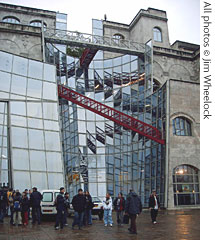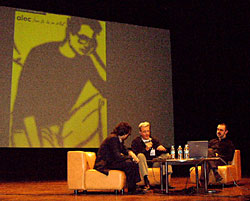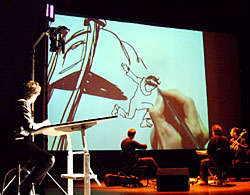>> The Once and Future Angoulême
>> Angoulême: Adventures In Comics' Capital City
More...

It's never a bad festival in Angoulême, but this January it was at least different. In the multiverse of the Festival International de la Bande Dessinée, which remains reigning champ as the western world's biggest comics festival, most of the daytrippers and casual punters probably didn't notice much of a change, but in this hump-year of the decade, the festival was rerouting its vision, as surely as the city of Angoulême is rerouting its ancient streets - events that are not entirely unconnected.
In point of fact, the changes, and bigger ones to come, have been in process for the last few years, the result of the long term plans of the festival's planners and the directors of the national comics museum, the Centre National de la Bande Dessinée, and of the changing tides of politics in Angoulême, the Charente region, and France itself.
This year saw the 32nd go 'round of the show, which takes place around the last weekend of every January in Angoulême, France. This year was a good year, but for many of the old hands it was a restless one. There was an epidemic of je ne sais crois running through the Secteur International gang of foreign comic pros, not unlike the traditional Angoulême bout of the flu. One of the regulars, a writer for a top comics news magazine, went around asking people if they'd seen anything that really excited them - or was it just that he was getting old?
 I think he was feeling what I was, that maybe there wasn't another great wave of French language comics coming down the pike any time soon. Many of us first came to Angoulême in the wake of the first wave of modern European creators, which brought us Moebius, Enki Bilal, Hugo Pratt and many others, or the more recent wave that grew out of L'Association and other alternative publishers, which gave us Lewis Trondheim, David B, Joann Sfar, Blutch, Thomas Ott and the team of Dupuy and Berbérian - the new wave, who, in many ways, have now become the modern bande dessinée mainstream. BD publishing is going well in France, but more and more of it is imported Japanese manga, Korean manhwa, and, yes, American comics.
I think he was feeling what I was, that maybe there wasn't another great wave of French language comics coming down the pike any time soon. Many of us first came to Angoulême in the wake of the first wave of modern European creators, which brought us Moebius, Enki Bilal, Hugo Pratt and many others, or the more recent wave that grew out of L'Association and other alternative publishers, which gave us Lewis Trondheim, David B, Joann Sfar, Blutch, Thomas Ott and the team of Dupuy and Berbérian - the new wave, who, in many ways, have now become the modern bande dessinée mainstream. BD publishing is going well in France, but more and more of it is imported Japanese manga, Korean manhwa, and, yes, American comics.
Last year, Jean-Marc Thévenet, the executive director of the festival, wrote about making it a truly international event, like the Cannes Film Festival. I didn't realise how sweeping the change would turn out to be. Over the last couple of years, long-time fixtures like the special invited 'guest country' exhibitions and the separate Album Étranger award were junked, with all comics published in French editions co-opted into the festival mélange.
The fest's awards, formerly the Alph'art's, and now the Palmarès d'Angoulême, have traditionally been a bastion of Franco-Belgian BDs, so it must have seriously peeved some of the Old Guard French chauvinists to see the top four prizes go to foreign creators - results that make you think about how many French films win the big awards at Cannes these days.
The Prix du Meilleiur Album went to POULE AUX PRUNES by Marjane Satrapi (published by L'Association), the Prix du Dessin to Jirö Tanigushi for LE SOMMET DES DIEUX (Kana), the Prix du Scénario to Ralf Köning (Glénat), and the Prix du Premier Album went to Alex Robinson for DE MAL EN PIS, the French edition of BOX OFFICE POISON. That's an Iranian woman, a Japanese man, a German and an American in the top four awards. In addition, the Pris de la Bande Dessinée Alternative went to Finland for the terrific GLÖMP ET LAIKKU anthology from Ex-aequo.
As I said, another sign of the times was the elimination of the Guest Country shows, which singled out a group of top creators from one country. Over the years we saw major exhibits from Great Britain, Japan, Italy, the US - just about every country with a comics scene, and a few without. The final one, last year, was the fictitious Groland, the setting for a popular comedy TV series, which Thévenet called a fitting end to the guest country concept. With a cutback in festival funding, the expense of bringing in numerous invited guests may have been an issue as well.
Instead, the accent was on one-on-one interviews with individual foreign creators, aided by a simultaneous translation headset system that enabled a diverse international audience to follow what was going on. The International Encounter series featured interviews with numerous creators, in particular Eddie Campbell and Art Speigelman.
 Alan Moore mania has officially struck France, and Campbell, who drew FROM HELL, bravely tried to discuss his own work as the interviewer kept harking back to the Northampton Necromancer, who was no doubt remote viewing the whole thing from his snake god temple. V FOR VENDETTA artist David Lloyd's interview was bluntly advertised as talking about Amiable Al, so it's only a miracle that Art Spiegelman's interviewer failed to steer the conversation toward finding a relationship between Moore and MAUS.
Alan Moore mania has officially struck France, and Campbell, who drew FROM HELL, bravely tried to discuss his own work as the interviewer kept harking back to the Northampton Necromancer, who was no doubt remote viewing the whole thing from his snake god temple. V FOR VENDETTA artist David Lloyd's interview was bluntly advertised as talking about Amiable Al, so it's only a miracle that Art Spiegelman's interviewer failed to steer the conversation toward finding a relationship between Moore and MAUS.
Spiegelman was there to talk about IN THE SHADOW OF NO TOWERS, which both chronicles his own harrowing experiences of the destruction of the World Trade Center, and comments on the Bush administration's use of the event to further its political agenda. The ebullient Spiegelman arrived fresh from being pinned a Chevalier of France by the Minister of Culture. "We don't have a Minister of Culture," he said, "In America, we just have a Minister of War".
At last year's festival there was some excitement over the selection of Zep as this year's festival president. Zep, who nom de plumed himself after the rock band Led Zeppelin, is the current wonder boy of French comics. His TITEUF albums, about a misbehaving bigfoot boy, have sold in the millions in a time of generally declining BD readership, particularly in his target demographic, kids. Still in his thirties, Zep brought a sense of enthusiasm and excitement to this year's show that's been lacking in some recent presidents' administrations, and, by my eyeball estimate, the festival crowd skewed younger than it had in years.
Judging by their new catalogues and what was at the show, the major publishers have jumped onto the Titeuf trend. Dozens of albums featuring funny, yet hip and trendy skateboardin' teens and tweens were on offer, the new frontline troops in the BD's war against the invading, market-devouring manga and manhwa.
It seemed like a good idea to bring in Zep, one of the new generation of artists, as president, and I held some hope the decision this year might be as adventurous. With Art Spiegelman having just been made a Chevalier of Arts and Letters by the French government, some of us dared to hope he might be the choice.
It was a long shot. Spiegelman is dismissed as a show-off in some quarters, and he's too, well, foreign for the old school, who are still burning from Robert Crumb's presidency a few years back. David B, Lewis Trondheim, Joann Sfar, or Dupuy and Berbérian, all alternative artists who've moved successfully into the mainstream, would also have been excellent choices. Instead, they went to the other extreme and elected seventy-one year old Georges Wolinski as, to quote L'ECHO DES SAVANES, the "new Pope" of BDs.
At first Wolinski seems a bland choice for president. I've found his recent work for L'ECHO, such as UNE VIE COMPLIQUÉE, pretty deadly - kind of like Woody Allen stories with drawings of genitalia. However, he was a key figure in international comics in the '70s as an editor, translator and publisher, and he's worked as an illustrator for the mainstream press for many years. A decent career retrospective could prove worthwhile, but he seems unlikely to draw in the kids.
 As always, the politics of the festival fascinated me. Angoulême is a city that's bet it's future on comics. It started with the first Salon International de la Bande Dessinée some 32 years ago, and it became official when the French national comics museum, the Centre National de la Bande Dessinée, was built in the early 90s.
As always, the politics of the festival fascinated me. Angoulême is a city that's bet it's future on comics. It started with the first Salon International de la Bande Dessinée some 32 years ago, and it became official when the French national comics museum, the Centre National de la Bande Dessinée, was built in the early 90s.
In that hyped-up, multimedia-crazy bygone age, the city planners wanted to turn the former paper-making town into a super-city of the graphic arts, a centre for BD, animation and digital art. To some extent they succeeded, but recent elections, and just plain economic reality, have put the kibosh to outgoing museum director André-Marc Delocque-Fourcaud's dream of creating a 'Cité de l'image', including cinemas, museums, schools and an amusement park.
As an outsider, I long thought of the festival and the museum as part of the same organization, which is far from the truth. In fact, Renaud Donnedieu de Vabres, the French minister of culture, used his visit to Angoulême to repeat his request that the festival join with the CNBDI as an Établissement Public de Coopération Culturelle, a cultural public utility.
Angoulême is in some ways more like a trade show than an American comics convention. The big publishers themselves buy space to sell their products, and they, along with other commercial sponsors and government funding, provide most of the capital for the festival. While the festival was the initial impetus for the BD'isation of the city of Angoulême, it has always gotten the smaller piece of the government pie, and this year its funding was pared further back.
The festival team has rejected calls to form an EPCC, preferring autonomy to increased government financing. Their long-term plan for the festival is to extend its reach to other regions and even other countries, while keeping its core event in Angoulême. Last year it produced a huge exhibit on cars in BD at the Mondial de l'Automobile in Paris, which, according the Thévenet, was seen by close to a million and half people. Other recent projects included an exhibit in the Paris Metro, and Blake and Mortimer shows in Paris and Switzerland.
As I mentioned, the town itself is in the middle of rebuilding much of its street infrastructure. The construction projects could render some of the festival's main sites unusable for several years, leading to rumours that the festival may leave Angoulême for neighbouring Rochelle next year. Thévenet has denied the rumours. Instead, it's likely the next festival will take place either around the town's theatre, or in a newly renovated area across the Charente river from the Centre National de la Bande Dessinée.
Rumours also haunt the CNBDI, which has a history of losing money. There doesn't seem to be any doubt that the museum will continue to exist, but the details of its exact fate are less clear. The CNBDI hasn't exhibited much of its permanent collection of comic art in recent years, except as part of special exhibitions.
In the first years of the museum they kept up an excellent retrospective of original art from all over the world, ranging from early European comics like the original graphic novelist, Rodolphe Töpffer, to modern American and Euro comics. It also featured interactive displays, like a kiosk where you could hear Jack Kirby talk about his work, and unusual sideshows, such as onetime Eisner assistant Gene Bilbrew's bondage comics.
Lately, the space that once held the permanent show has been used for single artist shows and theme exhibits where original art hangs alongside blow-ups and photocopies. The museum building has proved too small for the kind of big exhibits that could help the CNBDI financially, and fifteen years on from its creation, the place is showing signs of wear.
A scenario from happier economic days had a new museum being constructed next to the old one, but a left-wing victory in both the local and regional elections has led to a severe cutback in construction funding. As I write this, the exact future of the CNBDI is uncertain. However, despite its problems, the CNDBI remains an example to the rest of the world of what a comics museum can be.

This article is Ideological Freeware. The author grants permission for its reproduction and redistribution by private individuals on condition that the author and source of the article are clearly shown, no charge is made, and the whole article is reproduced intact, including this notice.


